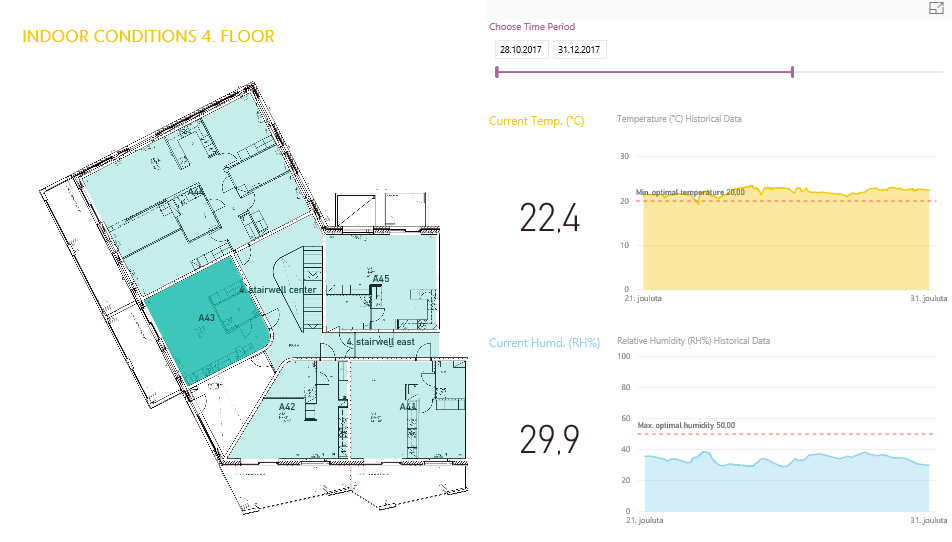Flooring, tiling, or painting on a concrete surface that is insufficiently dry can end up being a disaster. An experimental project recently used IoT sensors and AI to determine when it is safe to start finishing concrete surfaces.
Haste and Imperfect Conditions Lead to Failure
To successfully first cure and then dry concrete requires specific conditions. You need to maintain a temperature higher than 10°C and a relative humidity of greater than 80 percent in the concrete.
Once the concrete is hardened, you have to make sure that it is dry enough for finishing. Typically, the relative humidity should not exceed 82 percent. Some flooring materials require a humidity of less than 75 percent for successful application.
Finland, like many other countries in the North, does not offer an ideal environment for builders in the winter months. Tight project schedules and rapidly varying weather conditions can lead to structural mishaps. Damp concrete will damage flooring sooner or later. Furthermore, mold and microbe growth on moist surfaces will cause indoor air quality problems.
The IoT and AI Solution
A Finnish government-supported KIRA-digi experimentation project tested if IoT sensors could help in solving the concrete drying dilemma. Esa Eklund led the project at NCC Building in 2017.
Eklund has a master’s degree in computer science, and he specialized in renewable energy. Currently, he runs his own consultancy enterprise Kyberias Oy.
“We were looking for affordable, high-quality sensors that could collect information on humidity and temperature,” said Eklund. “We found a kickstarted project by a Finn, Lauri Jämsä. His RuuviTag sensor was a perfect fit for us. It is small, costs less than EUR 30, and can run for years. Both the hardware and software are open-source.”
The five-month KIRA-digi project called “Controlling the drying of concrete on construction sites” started in August 2017. The experimentation arena was a six-floor residential building in Helsinki. Its construction began in March 2017 and was completed in October 2018.
A total of 70 sensors collected temperature and humidity data in critical points of the test area. They formed a wireless mesh network that transmitted data via a central 3G/4G modem to a cloud service.
The team used machine learning algorithms to analyze the results. If the conditions were not optimal, the system alerted site managers to take corrective action.
Alternative Ways to Measure the Conditions
To a layperson, placing the IoT sensors inside the concrete structure looks like an optimal solution. After all, the traditional way to measure structural humidity is to drill a hole in the concrete slab and plug a measurement device inside. A large building contractor has a dedicated team to do that on a daily basis at different construction sites.
Eklund explained why the intuitive solution is not perfect: “We put a few sensors inside the structures themselves, but that turned out to be less than ideal. A layer emerges between the sensor and the concrete that insulates the sensor, resulting in incorrect readings.”
In the project, sensors were placed on the ceiling and walls that measured the room air conditions and not the concrete structures directly. The project team compared the sensor data with reference information from accurate, expensive meters and could determine the best conditions for drying the concrete.
“Still, the most reliable method is to take a sample from the concrete and study it at a lab,” Eklund reminded. “However, our method is a good-enough proxy.”
Promising Results
The contractor was pleased with the results. The builders could time precisely when to start doing floor finishes, which is critical from the project schedule point of view.
If the conditions for flooring are favorable, it is likely that the contractor does not have to do expensive repairs afterward.
An additional, unpredicted benefit surfaced. The contractor had to use portable oil-fired air heaters to dry the building. The heating was scheduled to run for a particular time. Because of the IoT system, the contractor knew when to turn those heaters off safely. It was sooner than expected, and that saved money.
The tested system was cost-efficient and technically feasible. As such, it is possible to productize it either as an in-house function or a new service.

Serge Skorin describes the experimentation project in his Master’s thesis. He writes that the construction time of the test building could theoretically have been up to 26 weeks shorter if the IoT solution had been fully implemented. That would have required changes, for example, in the HVAC installation schedule.
Experiments like this make it clear that IoT solutions can provide substantial benefits with marginal costs. However, the building process has to be reconfigured to make use of the technologies available.
To learn more about the experiment, contact Esa Eklund on LinkedIn or Ari Törrönen of NCC Building at ari.torronen(at)ncc.fi.
Title image: Aarni Heiskanen.



